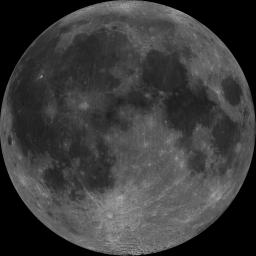Nearside of Earth’s Moon as Seen by the Clementine Spacecraft
Caption:
About 50,000 Clementine images were processed to produce the four orthographic views of the Moon. Images PIA00302, PIA00303, PIA00304, and PIA00305 show albedo variations (normalized brightness or reflectivity) of the surface at a wavelength of 750 nm (just longward of visible red). The image projection is centered at 0 degree latitude and 0 degree longitude. The lunar nearside is a contrast between dark and light albedo surfaces that has been fancied as the "Man in the Moon." Lunar terrain types are still designated by their 17th century name maria (dark albedo features also known as basins) and terra (brighter albedo features also known as uplands or highlands). The maria constitutes about 16 percent and the terra 84 percent of the lunar surface. The nearside is composed of about 30 percent maria. Extensive bright ray systems surround craters Copernicus (upper left center) and Tycho (near bottom). Studies have shown that two major processes, impact and basaltic volcanism have shaped the major physical features of the lunar surface.
Cataloging Keywords:
| Name |
Value |
Additional Values |
| Target |
Moon |
|
| System |
Earth |
|
| Target Type |
Satellite |
|
| Mission |
Deep Space Program Science Experiment (DSPSE) |
|
| Instrument Host |
Clementine |
|
| Host Type |
Orbiter |
|
| Instrument |
Ultraviolet/Visible Camera |
|
| Detector |
|
|
| Extra Keywords |
Crater, Grayscale, Impact, Volcano |
| Acquisition Date |
|
| Release Date |
1998-06-04 |
| Date in Caption |
|
|
| Image Credit |
NASA/JPL/USGS |
| Source |
photojournal.jpl.nasa.gov/catalog/PIA00302 |
| Identifier |
PIA00302 |

